Midsize Post-Modern Cruiser Shootout: Harley-Davidson Street 750 V. Honda CTX700N V. Kawasaki Vulcan S + Video
$7 gees and 700 ceecees is a pretty good place to be...
Kawasaki’s new Vulcan S forced us to ride these motorcycles again, and now we’re glad we did. Harley’s Street 750 and the new Vulcan are within 10 pounds, 1 horsepower and 400 dollars of each other. And the different-but-still-growing-on-us Honda CTX700N belongs in the mix as well. For the kind of riding most of us actually do most of the time, 700 or so cubic centimeters for around $7k seems like a pretty good place to be. Blatting around town, that is, in pursuit of one of MO’s secondary missions (keep Starbucks afloat), with the occasional blast out into the hinterlands to sniff the wildflowers – courtesy of the recent merciful rains here in SoCal – and ride like MOrons a little.
For the Harley-Davidson Street 750 however, there is precious little mercy. Or is there? How nice that the bike here most in need of aftermarket support has the most available. Mainly, we’re still puzzled how even the great and powerful H-D could release a modern motorcycle with such a useless front brake. More than once I had to add a third finger to the front lever to keep myself from rolling downhill while stopped at the side of the road. Tom Roderick claims he almost ran into the back of a truck the first time he rode the Street; Troy Siahaan wants to know how he’s supposed to trail brake when there is no brake? There’s a lot of value in the switch to the SBS brake pads we tested on a Street 750 last year. Even better, probably, would be this four-piston Brembo kit from Italy. Cara mia!
Luckily, it’s pretty easy to lock up the rear, so maybe H-D just sees the Street’s front/rear braking bias as a way to get people interested in flat-tracking again? (The Marketing Dept. really needs to get on board here: HBS, “Heritage Braking System.”)
We won’t go into the exposed wiring, crude welds and junk-drawer fasteners again. The Street is what it is. Many Harleys throughout the years have stressed owner involvement, and a little bit on the part of the proud new Street owner will go a long way. It’s a little sad, though, that the stylists didn’t just extend things like the bike’s plastic sidecovers to hide a few more of its privates (like Honda and Kawasaki did). Anyway, job one is that front brake.
Once that’s fixed, things are looking up. Even Troy S. likes its 750cc V-Twin: “The engine is the highlight of the bike; it likes to rev, makes decent torque and has that V-Twin character the others lack with their parallel-Twins.”
The Street’s V-Twin is 104cc bigger than the Kawasaki’s parallel unit, and likes to rev maybe even a bit more freely up to its 8000-rpm redline. The Kawi can rev on to 9500, but the Street uses its extra displacement to make its 43.5 lb-ft of torque (practically equal to the Kawi) lower in the powerband. In a drag race, there’s not much between them (except the Street’s clutch feels less abusable), which isn’t something we’ve ever been able to say vis a vis Harley vs. Kawasaki before. The six-speed gearbox isn’t the best or the worst (okay, on our ScoreCard it’s the worst of these three), but it gets the job done: Nobody complained about false neutrals, hard shifting or missed shifts.
The Street also finished last in the Handling category, with both of my co-testers using the word truckish to describe its steering. Personally, I don’t feel it. The Street has right around 4.5 inches of trail just like the other two here, a shorter wheelbase than the Vulcan and skinnier tires than either of them, but it does have the laziest rake at 32.0 degrees. We wonder if the strange-profiled (kind of flat-looking) 140/75-15 rear Michelin Scorcher gives that hard-to-turn feeling? Maybe its handlebar is a bit narrower? To me, the Street feels nimbler and more light-footed than the other two bikes.
What we also don’t agree upon at all is comfort: Tom and Troy both rated the Street last in the Ergonomics/Comfort category, while yours truly rated it first. Its footpegs are kind of high for taller riders. Tom, who’s 5-foot, 11-inches, says its cockpit is cramped and “simply isn’t designed for anyone north of five-foot nine.” He’s probably correct, but for 5’8 me, the Street’s more-standard-than-cruiser ergonomic triangle is the other big thing it has going for it besides its engine. A compact cockpit with closer footpegs makes it feel more controllable to smaller riders, a subset that includes yours truly. (H-D offers a “Reduced Reach” seat and a Tallboy one, $201.95 each, along with Reduced Reach handlebars in black or chrome, for $69.95.) Thanks to its cush seat and surprisingly good suspension, the Street beat out the Vulcan in the Suspension category. It soaks up the bumps pretty damn well, and encourages maniacal riding like few other Hogs.
Harley-Davidson Street 750
+ Highs
- Short people got no reason not to like it
- This Harley makes as much power as the Kawasaki!
- Looks great from a distance and/or in the dark
– Sighs
- Worst production front brake in the modern world
- Needs its owner to tidy up a little bit
- Cramped ergos for big people.
Alas, the poor little Street’s egregious shortcomings outweigh its innate raw goodness. My upvotes could not outweigh the poopoos of my compadres, and so the Street finishes in a resounding last place. America loves its underdogs: Here’s to Harley for keeping on building them for us.
Three Bikes Go In, Two Come Out!
That leaves the new Vulcan S and the year-old Honda CTX700N to duke it out to the finish, sort of a battle between the Kawi’s old-school Japanese cruiser style vs. the Honda’s new-tech functionality with a nod toward tradition. The Kawasaki’s slightly smaller parallel-Twin makes substantially more power and a bit more torque than the Honda’s 21cc-bigger, low-revving 670cc inline-Twin, but the Honda gets more than 60 mpg most tanks and runs so smoooooth…
As Evans Brasstacks learned at the Vulcan’s coming-out party, Kawasaki bumped the Versys 650 Twin’s flywheel mass 28% to make it more cruiserish, and its intake funnels, throttle bodies, exhaust headers and ECU were also modified to improve bottom-end power. Where our last Versys 650 made 54.9 hp at 8200 rpm, the Vulcan pumps out 56.1 at 7300. Also 43.4 lb-ft. of torque at 5700 rpm, compared to the Versys’ 38.9 lb-ft. at 7100 rpm.
On the ScoreCard, the Vulc engine wins: “Like the Harley, the engine is the highlight of the Vulcan S,” says Troy. “It likes to rev and is equally as athletic as the Street 750, if not moreso.” Tom says: “Definitely the best engine in this group. It’s revvy and fun, and more powerful than the larger displacement V-Twin powering the Harley.” (Right, by 0.55 hp. The Harley makes 0.13 more ft-lbs of torque at only 3800 rpm.)
Meanwhile, the Honda’s low-revving half-a-car engine hangs in there with just 43 hp (at 6100 rpm). Its max torque of 41.5 lb-ft happens at 4700 rpm, but it’s making more than 40 at only 3200 rpm (just like the Harley), and doesn’t have any trouble keeping up with the group until the pace really heats up. Which it really doesn’t very often on these bikes. The Honda has the best gearbox of the group, with short positive throws and a light clutch. The Kawi’s gearbox is good too, but there’s a bit of slop in its linkage, introduced by its new “Ergo-fit” system, which lets you move the forward-mounted foot controls between three positions: “Long throws between gears makes for sloppy shifting,” says T Roderick. True that. The Vulcan does provide adjustable levers for both brake and clutch, though, and its rubber-mounted handlebar keeps the vibes at bay; 80 mph at 6000 rpm isn’t as serenely smooth as the Honda, but it’s close. The Street’s (solid-mounted) handlebar is quite a bit vibier at freeway speed. Also, the ABS brakes on our Kawi only add $400 to the Vulcan’s $6,999 bottom line. If you want ABS on the Honda, you’ll have to add $600 and take the auto gearbox too. And if you want it on the Harley, you are SOL, as they say in the vernacular.
The only place the Vulcan really comes up short is in the Suspension category, where it finishes last on our ScoreCard. It uses the same type lay-down shock on the right side as its sister-bikes Versys and Ninja 650, but unlike those two, the Vulcan works its shock through a linkage system. Kawasaki claims there’s 3.2 inches of rear-wheel travel, and they’re usually telling the truth, but over bumps that the Harley and Honda absorb nicely, the Vulcan feels almost like a hardtail, connecting with powerful gluteal uppercuts that put daylight between seat and rider. Which is sad, because sister Versys is so comfortably the opposite.
Kawasaki Vulcan S
+ Highs
- Adjustable ergonomics is a great idea
- Fun, revvable motor
- Longest and lowest
– Sighs
- Harsh rear suspension
- Kawasaki still going for the gold in Ugly Exhaust Olympics
- Are you sure you don’t want this engine in the Versys?
If it’s homogenized semi-raw-edged Japanese cruiser you’re after, you want the Kawasaki. If it’s suave and sophisticated, it’s hard to beat the CTX, which we all agreed has the best suspension, the best seat – and would win the ergonomics sweepstakes if only its footpegs were in the same zip code as the rest of it. If you have giraffe legs and fused knees, the CTX is your bike, and in fact, for urban trawling, the footpegs are less of a problem than they are on the highway, where way-forward feet make it that much more difficult to brace against the wind.
There really aren’t any frills on the Honda, which keeps the price down, but everything that is there is elemental, well-lubricated and functional, from the easy-reading LCD instruments to the Pro-Link shock out back that serves up 4.3 inches of the best suspension here, and helps the Honda handily win the Handling portion of the competition. The only thing missing from it is the excellent storage compartment of its sister-ship NC700X, a thing I promised I wouldn’t point out again but failed. Every Honda used to come with a helmet lock. No more.
Honda CTX700N
+ Highs
- So dialled it’s hard to believe it’s only two years old
- Fuel mileage is hybrid-like
- Is “low-key cruiser” an oxymoron?
– Sighs
- The footpegs arrive two minutes before the rest of the motorcycle
- Its “storage compartment” is a cruel joke next to the NC700X’s
- Is “practical motorcycle” also an oxymoron?
The Winner Is…
And the winner, in a photo finish, is the new Kawasaki Vulcan S – edging out the Honda by less than a percentage point in both Objective and Subjective scoring to take the overall win by 0.34%. If you’re torn, find your nearest Honda/Kawasaki dealer and sit on both to decide. If you like it when the salesperson comes over to talk to you and you have hours to kill, you’re probably a Kawasaki guy. If you wish he’d go away so you can make up your own mind and get on with your life, the Honda is for you.
Say, this was fun. Tearing around like maniacs in the canyons is always good, but slowing down a little and taking in the sights is a whole other kind of soothing. Anybody need a latte?
Midsize Post-Modern Cruiser Shootout Scorecard | |||
| Category | Harley-Davidson Street 750 | Honda CTX700N | Kawasaki Vulcan S |
|---|---|---|---|
| Price | 93.3% | 100% | 94.6% |
| Weight | 95.1% | 100% | 97.0% |
| lb/hp | 96.7% | 79.5% | 100% |
| lb/lb-ft | 98.3% | 98.3% | 100% |
| Engine | 82.5% | 82.5% | 85.8% |
| Transmission/Clutch | 73.3% | 83.3% | 75.0% |
| Handling | 68.3% | 80.0% | 75.0% |
| Brakes | 48.3% | 76.7% | 81.7% |
| Suspension | 73.3% | 83.3% | 70.0% |
| Technologies | 48.3% | 60.0% | 74.2% |
| Instruments | 58.3% | 78.3% | 76.7% |
| Ergonomics/Comfort | 66.7% | 76.7% | 78.3% |
| Quality, Fit & Finish | 50.0% | 81.7% | 78.3% |
| Cool Factor | 75.0% | 68.3% | 75.0% |
| Grin Factor | 66.7% | 71.7% | 71.7% |
| Overall Score | 72.0% | 80.9% | 81.3% |
Midsize Post-Modern Cruiser Shootout Specs | |||
| Harley-Davidson Street 750 | Honda CTX700N | Kawasaki Vulcan S | |
|---|---|---|---|
| MSRP | $7,794 ($7499 in basic black) | $6,999 (DCT ABS $7,599) | $7,399 (Vulcan S non-ABS $6,999) |
| Engine Type | 753cc liquid-cooled 60-deg. V-Twin | 670cc liquid-cooled parallel Twin | 649cc liquid-cooled parallel Twin |
| Bore and Stroke | 85.0 x 66.0mm | 73.0 x 80.0mm | 83.0 x 60.0mm |
| HP | 55.5 hp @ 7900 rpm | 43.4 hp @ 6100 rpm | 56.1 hp @ 7300 rpm |
| Torque | 43.5 @ 3800 rpm | 41.5 lb-ft. @ 4700 rpm | 43.4 lb-ft. @ 5700 rpm |
| Fuel System | Mikuni single-port EFI, 38mm throttle body | PGM-FI, 36mm throttle body | EFI; two 38mm throttle bodies |
| Ignition | Digital inductive | Digital inductive | Digital inductive |
| Compression Ratio | 11.0:1 | 10.7:1 | 10.8:1 |
| Valve Train | SOHC; 4 valves/cyl. | SOHC; 4 valves/cyl. | DOHC; 4 valves/cyl. |
| Emissions | Closed-loop 3-way catalytic converter | current EPA and CARB in California | current EPA and CARB in California |
| Transmission | 6-speed | 6-speed | 6-speed |
| Final Drive | Belt | Chain | Chain |
| Front Suspension | 37mm fork; 5.5 in. travel | 41mm fork; 4.2 in. travel | 41mm fork; 5.1 in. travel |
| Rear Suspension | Twin coil-over shocks, preload adjustable; 3.5 in wheel travel | Pro-Link single shock; 4.3 in. travel | Single shock; 3.2 in wheel travel; adjustable spring preload |
| Front Brake | 292mm disc; 2-piston caliper | 320mm disc; 2-piston caliper | 300mm disc; 2-piston caliper; ABS |
| Rear Brake | 260mm disc; 2-piston caliper | 240mm disc; single-piston caliper | 250mm disc; 2-piston caliper; ABS |
| Front Tire | 100/80-17 | 120/70-17 | 120/70 – 18 |
| Rear Tire | 140/75-15 | 160/60-17 | 160/60-17 |
| Rake/Trail | 32°/4.5 in (115mm) | 27.7°/4.4 in (114mm) | 31°/4.7 in (119mm) |
| Wheelbase | 60.4 in | 60.2 in | 62.0 in |
| Seat Height | 27.9 in | 28.3 in. | 27.8 in |
| Curb Weight | 509 lb | 484 lb. | 499 lb |
| Fuel Capacity | 3.5 gal | 3.17 gal. | 3.7 gal |
| Observed fuel mileage | 42 mpg | 61 mpg | 45 mpg |
| Storage Capacity | none | tiny glovebox | zilch |
| Available colors | Black, Maroon | Black | Green, White, Red |
| Warranty | 24 months, unlimited miles | One year, unlimited miles | 24 months (Limited Factory Warranty) |
More by John Burns



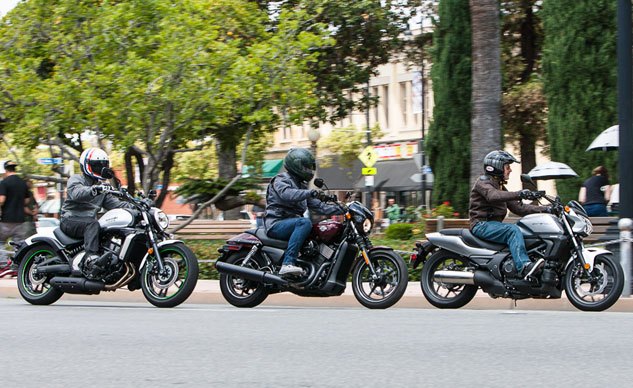
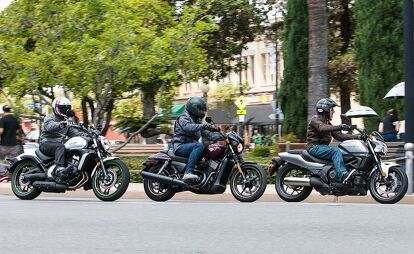




































































































































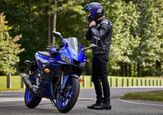
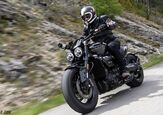
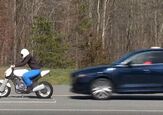
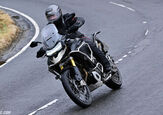
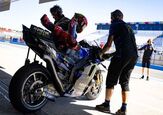
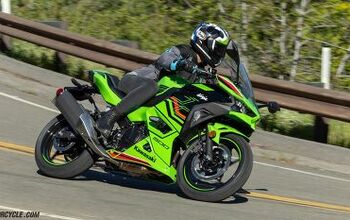
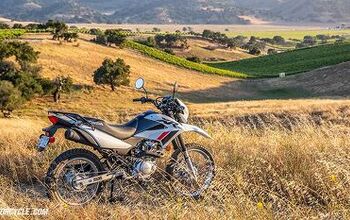

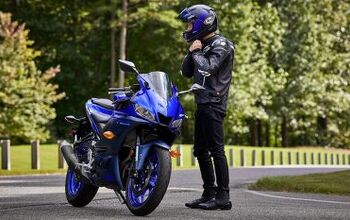
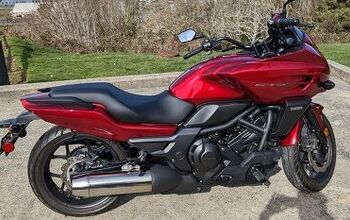
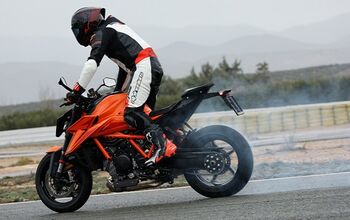
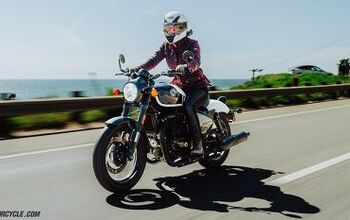
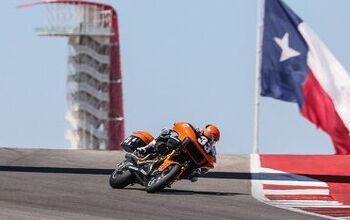
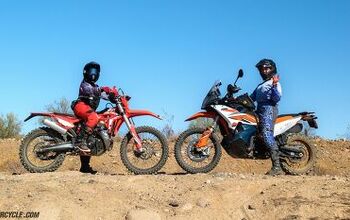
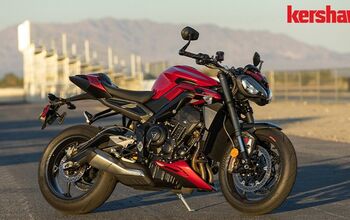
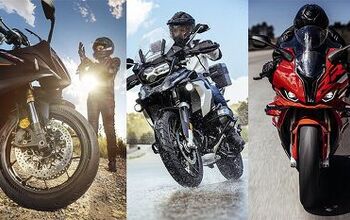
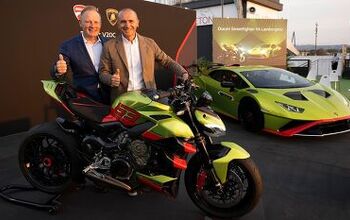
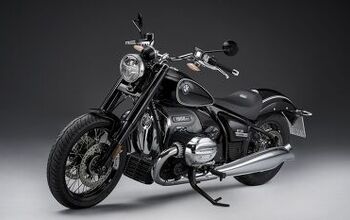
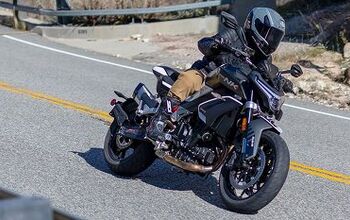


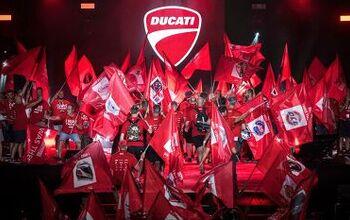

Comments
Join the conversation
Honda is ugly as sin. A very cheap, "vanilla" looking bike. I would never buy this bike, even if it was cheaper...
I went from a 2014 Yamaha Bolt R-spec to the 2015 Vulcan S and the bikes are completely two different rides. The Yamaha apparently gets pretty good scores for handling from most reviewers but the handling coming from the Vulcan S makes it feel like a tractor by comparison. I've been running my Vulcan S pretty heavy lately and still have yet to scrape the pegs, even while getting a knee halfway out. The bolt (and I'm assuming the street based on stance and build) seemed to grab the ground like clockwork whenever I wanted to push it.
Back before I even bought my bolt I was looking at the street 750 but couldn't bring myself to trust in the outsourced revolution X. Probably not a huge deal but it's more of a moral judgement on my end. Glad I made the choice I did seeing this talk.
BTW, hunkered down, the S whines up to 110MPH like silk, although I've3 stayed in it once and tapped 117MPH, IMO, max speed should be somewhere around 120MPH, Although after 100-110 it's like a gradual crawl.